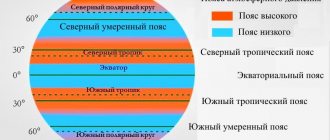An anticyclone is the antipode of a cyclone. The atmospheric pressure in this air vortex is increased. Two air flows, having met, begin to intertwine in the form of a spiral. Only in anticyclones does the atmospheric pressure increase as it approaches the center. And in the very center the air begins to descend, forming downdrafts. Then the air masses dissipate, and the anticyclone gradually fades.
Why does an anticyclone form?
Anticyclones appear as if in contrast to cyclones. Rising air currents escaping from the center of cyclones create excess mass. And these flows begin to move, but in the opposite direction. At the same time, anticyclones are much larger in size than their “brothers”, since their diameter can reach 4 thousand kilometers.
In anticyclones that appeared in the northern hemisphere, the air flow rotates clockwise, and in those that arrive from the south, the flow rotates counterclockwise.
Where do anticyclones form?
Anticyclones, like cyclones, form only over certain areas of land, in certain climate zones. Most often they originate over the vast expanses of the Arctic and Antarctic. Another species originates in the tropics.
Geographically, anticyclones are more tied to certain latitudes, so in meteorology it is customary to name them by the place of formation. For example, meteorologists distinguish Azores and Bermuda, Siberian and Canadian, Hawaiian and Greenland. It has been noticed that the anticyclone that originates in the Arctic is much more powerful than the Antarctic one.
Types of cyclones
An area of low atmospheric air pressure varies in strength. There are 4 types of cyclones:
- A disturbance characterized by air movement at a speed of no more than 17 m/s.
- Depression - speed is in the range of 17-20 m/s.
- I call a storm a cyclone whose center moves up to 38 m/s.
- If the movement of the “eye of the storm” exceeds 39 m/s, it is already a hurricane.
This is a generally accepted classification. Nature sometimes throws “surprises” at humanity in the form of storms of unexpected strength in uncharacteristic latitudes. For example, in 1999, Western Europe was shaken by the powerful hurricane Lothar. Meteorologists could not foresee it, since its monstrous power led to the sensors going off scale. Some of them didn't even work.
More than 70 people died due to the raging disaster.
Signs of an anticyclone
It is very simple to determine that an anticyclone is hanging over some part of our planet. Clear, windless weather, cloudless skies and an absolute lack of precipitation will reign here. In summer, anticyclones bring with them stifling heat and even drought, which often leads to forest fires. And in winter these whirlwinds give severe, bitter frosts. Frosty fogs can often be observed during this period.
The most catastrophic consequences are considered to be a blocking anticyclone. It creates a stationary area over a certain area and does not allow air currents to pass through. This can last for 3-5 days, very rarely longer than half a month. As a result, this area becomes unbearably hot and dry. The last such powerful blocking anticyclone was observed in 2012 in Siberia, where it dominated for three months.
Atmosphere pressure
Air has mass, albeit small. The mass of 1 liter of air at sea level is 1.3 g. But the huge volume of the earth’s atmosphere leads to the fact that the atmosphere presses on every square centimeter of the earth’s surface with a force equal to 1 kg! This average air pressure above ocean level at a latitude of 45° at a temperature of 0 °C is taken as normal pressure. It corresponds to the weight of a mercury column with a height of 760 mm and a cross section of 1 cm?. The millimeter of mercury (mmHg) is a non-system unit of pressure measurement.
With increasing altitude, atmospheric pressure decreases because the higher the point is located, the lower the height of the air column pressing on it. In addition, as altitude increases, the air discharges, becomes lighter and its pressure decreases.
The air also discharges as the temperature rises. The hotter the air, the lower the atmospheric pressure.
Geographic latitude also affects the amount of atmospheric pressure, since it determines the thickness, and therefore the mass, of the troposphere. The greater the mass of air, the higher the atmospheric pressure. Let's remember that the troposphere is thickest above the equator. It would seem that at the equator the atmospheric pressure should be higher than at the poles. But, on the other hand, the air at the equator heats up greatly, becomes rarefied and relatively light, and this contributes to a decrease in pressure. The direction of vertical air movement also affects the magnitude of atmospheric pressure. As air descends, atmospheric pressure at the earth's surface increases, and as air rises, it decreases. At the equator, ascending currents of warm air, heated by the earth's surface, predominate. In the upper troposphere, these flows flow towards the poles (polar latitudes), where they descend and form areas of high pressure.
As a result, near the equator there is a belt (region) of constantly low atmospheric pressure, and in the areas of the poles - constantly high.
Like temperature, atmospheric pressure varies with latitude and altitude. In latitude, it varies zonally and azonally, that is, unrelated to latitude, unevenly.
According to latitudes, the earth's surface is divided into seven latitudinal atmospheric pressure zones, which are called pressure zones - one equatorial, two tropical, two temperate and two polar.
The equatorial belt of low atmospheric pressure is located on both sides of the equator between 10° north and 10° south latitude.
Tropical high pressure zones are located between 10° and 30° -40° northern and southern latitudes.
Moderate belts of low atmospheric pressure are located between 30° - 40° and 60° - 70° northern and southern latitudes.
Polar belts of high atmospheric pressure lie above 60° - 70° northern and southern latitudes, that is, practically inside the polar circles.
The boundaries of the atmospheric pressure belts are not clearly defined, since depending on the time of year they shift slightly to the north or south.
Why do belts of high and low atmospheric pressure alternate? Why does there not be a gradual increase in atmospheric pressure when moving from the equator to the poles?
The point is the peculiarities of air movement.
At the equator, the earth's surface becomes very hot and transfers a lot of heat to the air. The air expands and rises, as a result of which the atmospheric pressure decreases and an equatorial low pressure belt is formed.
As it rises, warm air cools. At the upper boundary of the troposphere, equatorial air masses move north and south. In the region of the 30th parallel, they descend down, forming tropical belts of high atmospheric pressure.
The descending air quickly heats up. Due to this, in the tropics there is a “paradoxical” combination of high temperatures with high atmospheric pressure.
At the poles, in areas of low temperatures, cold air sinks to the earth's surface, forming polar high pressure belts. From here, the air moves to warmer temperate latitudes, and this movement occurs near the earth's surface, in the lower part of the troposphere.
In temperate latitudes, cold polar air heats up, expands and rises, forming belts of low atmospheric pressure. Having risen to the upper boundary of the troposphere, air masses return to the poles, where they cool and descend to the earth's surface.
Note! The Northern Hemisphere's low-pressure belt only exists in summer! In winter, due to a sharp drop in air temperature, atmospheric pressure over the continents of the Northern Hemisphere increases greatly and a low pressure belt remains only over the oceans in the form of two closed areas of low pressure - the Icelandic and Aleutian lows. The center of the Icelandic low is located near the island of Iceland, and the center of the Aleutian low is near the Aleutian Islands of the Pacific Ocean. On the contrary, winter maxima (areas of high pressure) – Asian and North American – form over the continents of the Northern Hemisphere.
In summer, the belt of low atmospheric pressure in the temperate latitudes of the Northern Hemisphere is restored. A huge area of low atmospheric pressure is formed over Asia, centered in tropical latitudes - the Asian Low or Asian Anticyclone.
Over the oceans in tropical latitudes, there are highs throughout the year, also called cyclones - North Atlantic (Azores), North Pacific, South Atlantic, South Pacific and South Indian. This is due to the fact that the oceans in the tropics are always less heated than the continents and the pressure above them is higher.
The existence of maxima and minima at the same latitudes is an example of an azonal change in atmospheric pressure. The presence of belts and areas of different atmospheric pressure has a significant impact on air currents, weather and climate.
On maps, the distribution of atmospheric pressure over the earth's surface is shown by lines connecting points with the same pressure. These lines are called isobars. Most often, the isobars of January and July, the months with maximum and minimum atmospheric pressure, are indicated on maps.
Atmospheric pressure is constantly changing and the main reason for these changes is changes in air temperature. Atmospheric pressure is measured using special instruments - barometers. The first barometers were mercury and consisted of an open container with mercury (plate) into which a test tube was placed with the hole down. When the atmospheric pressure increased and put more pressure on the mercury in the plate, the level of mercury in the test tube rose, and when the pressure decreased, the level of mercury in the test tube fell.
Mercury barometers were difficult to use. Over time, they were replaced by aneroid barometers. An aneroid barometer consists of a hermetically sealed hollow thin-walled box, inside of which negative air pressure is created (that is, the air is rarefied). When atmospheric pressure changes, the walls of the box are pressed in or out. These vibrations are transmitted to a pointer connected to the box, which moves along the scale.
As already mentioned, atmospheric pressure decreases with increasing altitude. The vertical distance at which atmospheric pressure decreases by 1 mmHg. Art., is called the pressure level. In the lower layers of the troposphere, up to a height of 1 km, the pressure level is 10 m. Above 1 km, the pressure level lengthens, since as the altitude increases, the rate of decrease in atmospheric pressure slows down.
Atmospheric pressure changes not only in the vertical, but also in the horizontal direction. There is an indicator characterizing the change in atmospheric pressure in space (vertically and horizontally), which is called the baric gradient.
The pressure gradient is a vector, that is, a mathematical quantity characterized by a numerical value and direction. In meteorology, maps usually use the horizontal component of the pressure gradient at sea level or some other level, which is called the horizontal pressure gradient. The pressure gradient is directed normal to the isobar in the direction of decreasing atmospheric pressure.
Instead of a vertical baric gradient, which reflects the change in atmospheric pressure with height, the inverse value is often used - the baric step.









